Ladakh
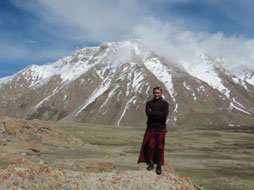
Ladakh is one of the most sparsely populated regions in India, as its culture and history are closely related to that of Tibet, it is known as the “Little Tibet”. In the extreme north of India , it extends from the Siachen Glacier, in the Karakoram range to the north, to the main Great Himalayas to the south. The largest town in Ladakh is Leh, the main populated regions are the river valleys, but the mountain slopes also support the pastoral Changpa nomads.
Its name derives from “La-dags” meaning “land of mountain passes” and it is a region characterized by high-altitude desert hemmed in by the mighty Himalayan and Karakoram ranges.
Cut off from the rest of the country by snow for seven months of the year, India’s northernmost region comes alive in summer. Deserts are lubricated by rivers swollen with snow melt and the run-off from dazzling turquoise lakes.
Life of the farmers
The land is irrigated by a system of channels which funnel water from the ice and snow of the mountains. The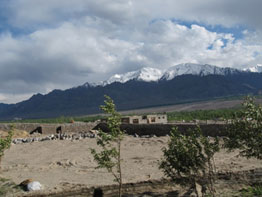 principal crops are barley and wheat. The farming of barley, wheat and vegetables happens in a hurry hereabouts. No sooner are crops sown in the thin Ladakhi soil than winter starts drawing in and the ground becomes frozen solid for months on end. It’s enough to make villagers throw in the towel and head for the bright lights of Leh. That’s where fortunes are made, after all.
principal crops are barley and wheat. The farming of barley, wheat and vegetables happens in a hurry hereabouts. No sooner are crops sown in the thin Ladakhi soil than winter starts drawing in and the ground becomes frozen solid for months on end. It’s enough to make villagers throw in the towel and head for the bright lights of Leh. That’s where fortunes are made, after all.
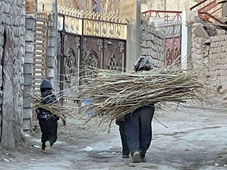
The effects of global climate breakdown are increasingly evident in the ecologically fragile Himalayas. Ladakhis say they have never witnessed such erratic climatic conditions. Flash floods caused by short but heavy downpours are worrying enough, but a pattern of diminishing snowfall and resulting drought has more serious long-term implications.
The glacier on which Leh depends is predicted to melt completely within five or six years and hoteliers are already drilling boreholes in search of elusive groundwater.
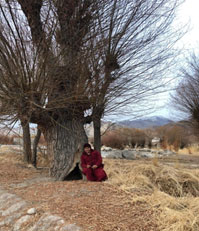
The shortage isn’t helped by the rush to modernize. Replacing traditional dry toilets with Western flush systems places greater demands on scarce water resources, for example.
Another problem is due to the characteristics of this Himalayan region, majority of farmers are poor and they often let their land be uncultivated and waste. The growing of a sort economic tree, the willow trees, which can bring more benefits for them, have to self-develop in such harsh wild conditions and with the destroying and exploitation environment, these trees are lesser and lesser even their life span is possible up to the hundred year.
Life of Nomads
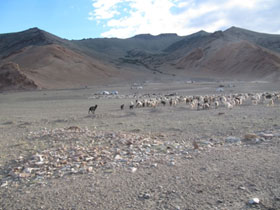 The Changthang region is located approximately 300 kms south east from Leh, Ladakh on the north western plains of the Tibetan plateau in India.
The Changthang region is located approximately 300 kms south east from Leh, Ladakh on the north western plains of the Tibetan plateau in India.
Perched at an average elevation of 4,700 m, the Changthang (meaning Northern Plateau in Tibetan), is a high altitude desert. It is an impressionable landscape, one whose striking beauty, vast emptiness and unforgiving terrain will not vanish quickly from memory.
Muted brown mountains common to the Trans-Himalayan plateau contrast starkly with the white blanketed peaks separating mountain from sky. The ridges and valleys are tiger-striped with colours from a seemingly unnatural palette of dusty pinks, purples, emeralds and gold. Lush valley floors rich with grass lands and giant lakes extend to the vastness of open desert plains. Carcasses lying on a parched earth cracked open by the extremities serve as a reminder of the daily fight needed to survive in such an inhospitable terrain.
The Changthang is classified as a wildlife sanctuary and is home to many rare species of flora and fauna. Birds such as the black necked crane, the Kiang (wild ass) and the Tibetan gazelle, a species on the brink of extinction, are found in the region’s high altitude plains.
The Changthang is also home to the Changpa, some of India’s poorest nomads.
Relocating approximately 8-10 times a year, the Changpa move with their goats and sheep in search of the wetlands of the lake basin in summer and to the lower plains in winter, when temperatures frequently drop below -30. Due to heavy snowfall, communities are often snowed in for up to 8 months a year.
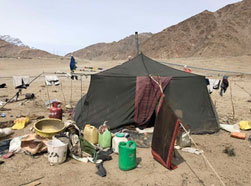 The Changpa are nomadic pastoralists who originally migrated from Tibet in the 8th Century BC. They typically have no fixed address, mostly living in robos or tents made from yak wool which at times house up to 12 family members.
The Changpa are nomadic pastoralists who originally migrated from Tibet in the 8th Century BC. They typically have no fixed address, mostly living in robos or tents made from yak wool which at times house up to 12 family members.
During the short summer months the sun beats fiercely on the higher plains. By contrast, winter is so brutally cold that families rarely venture outside. Conditions are extreme and life is tough.
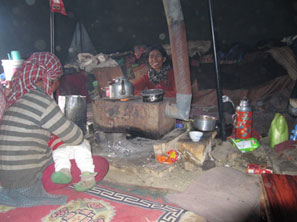 Due to a lack of natural resources, families burn cow dung as fuel for heating lit with kerosene. A small metal stove sits as the centrepiece to the robo, its chimney poking out through the open hole in the roof which offers little protection against the elements. The carbon dioxide fumes let off from these stoves combined with a diet lacking in essential nutrients contribute to the poor health often experienced by many nomads.
Due to a lack of natural resources, families burn cow dung as fuel for heating lit with kerosene. A small metal stove sits as the centrepiece to the robo, its chimney poking out through the open hole in the roof which offers little protection against the elements. The carbon dioxide fumes let off from these stoves combined with a diet lacking in essential nutrients contribute to the poor health often experienced by many nomads.
Due to isolation and remoteness many Changpa have limited access to basis resources and infrastructure including health care or early childhood services.
While the situation is rapidly improving, maternal health issues are still not uncommon with many children suffering from curable illnesses which in the past, have contributed to a high child mortality rate.

The main source of income for the Changpa is derived from livestock. Basics such as grain, vegetables and cooking utensils are traded for meat, pashmina wool or milk and butter from goats and sheep which their families can do without. For families with a herd of less than 20 goats or sheep, their daily income is likely to equate to approximately 25-70 US cents a day, other families even do not own any goat or sheep.
Sources
- John Lancaster. India’s Nomads. National Geographic, February 2010. http://www.lillefro.org/a-nomadic-life
- Ladakh. From Wikipedia. https://en.wikipedia.org/wiki/Ladakh
- Nawang Kunphel. Project of Pennees Row (Perennial trees growing for life), 2021
- Tim Pile. Ladakh: the good, bad and ugly sides to India’s ‘Little Tibet’, high in the Himalayas, Post magazine, 1st Aug 2019. https://www.scmp.com/magazines/post-magazine/travel/article/3020805/ladakh-good-bad-and-ugly-sides-indias-little-tibet
